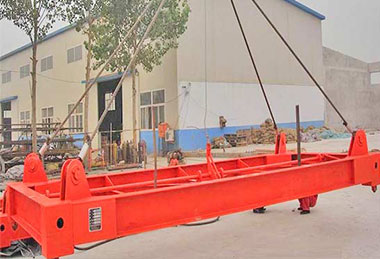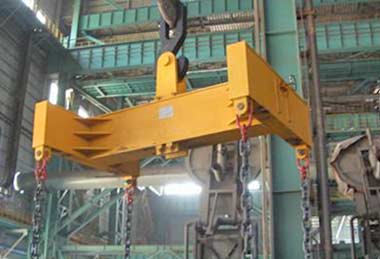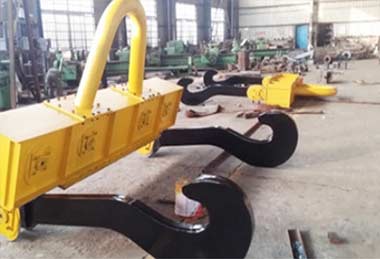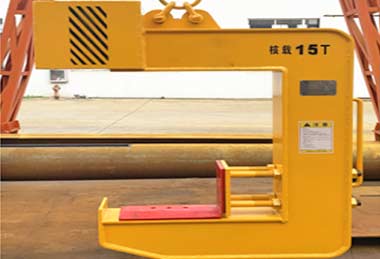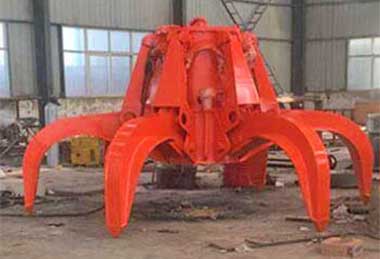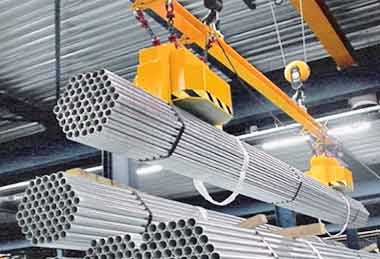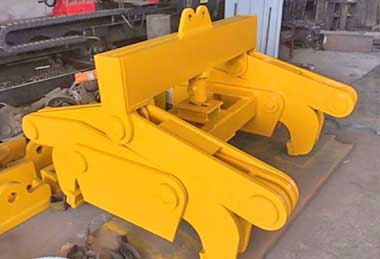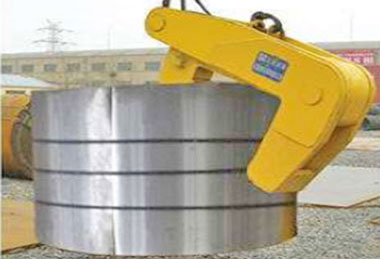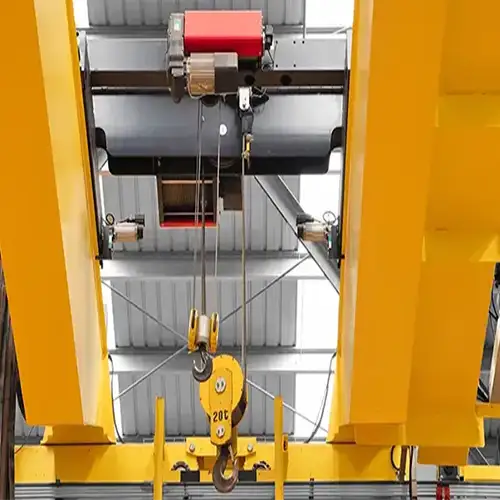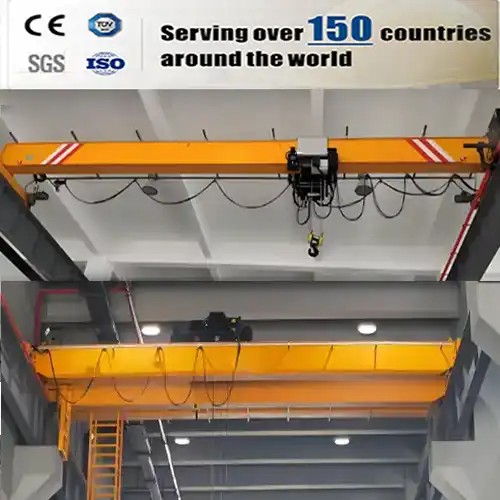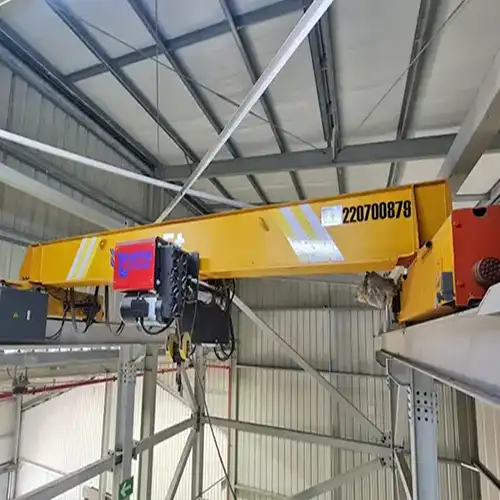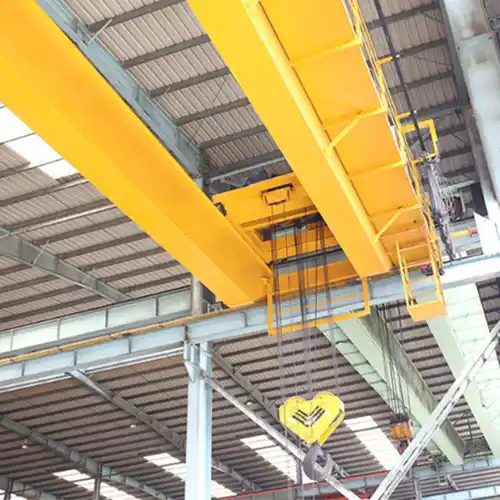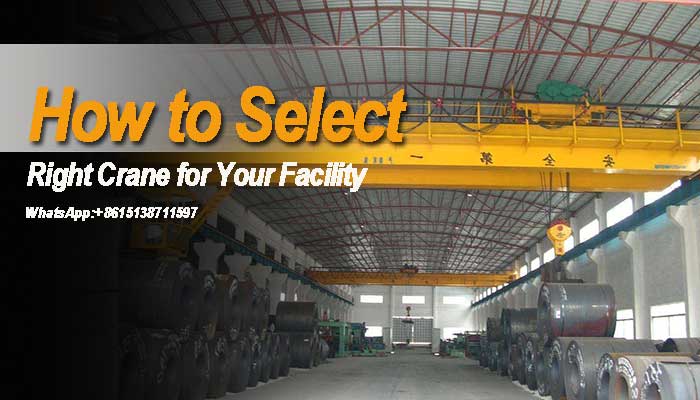
How to Choose the Right Overhead Crane for Your Application?
Your overhead crane is one of the most crucial pieces of equipment in your operation. It actually does the most of the heavy lifting in your business, so you'll want to be sure you have the best equipment for the job. The size of your facility and your budget aren't the only factors to consider when selecting an overhead crane. There are numerous elements to consider, not just in terms of your facility, but also in terms of the applications for which you will require it, so make an informed decision.
Here are some general guidelines to help you choose the best overhead crane equipment for your needs.
Think About Your Facility /Warehouse/Workshop /Workstations
Before you start looking at individual cranes, take a good look around your facilities and figure out what size and type of cranes will work best for you.
This includes the following:
- Measuring the area that the crane will be able to reach. In addition to the width and length of your structure, you'll need to take into account any height limits or ceiling obstructions that could interfere with the crane's operation or violate OSHA standards.
- Identifying any potential roadblocks to the crane's mobility. OSHA requires at least 3 inches of space overhead and 2 inches of clearance laterally around crane equipment, so it's critical to inspect your site and identify any potential impediments to appropriate and safe operation.
Recognize how the crane will be installed in the building. You may be able to employ a portable system that doesn't require any installation depending on your applications and the construction of your facility. If you need a permanent system installed, however, make sure your facility has the proper foundation and/or structure.
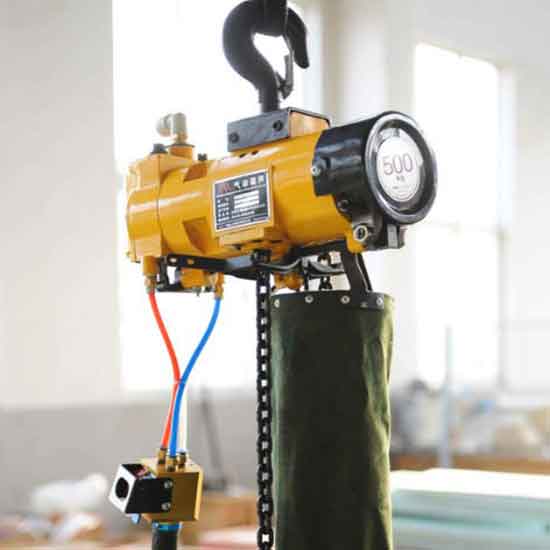
Safe & fast air operated hoists. Air hoist & pneumatic hoist is a compressed air powered hoist & air operated hoists, various hoist designs,wide specification, good price. 50~32000kg Air hoist for sale.
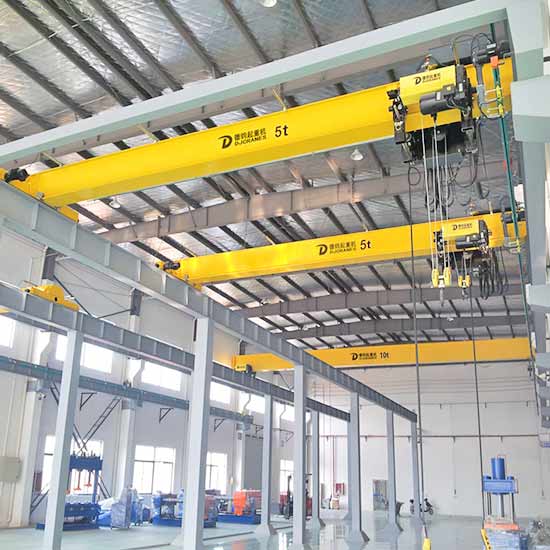
European standard overhead hoist crane, Small overhead crane:European single girder overhead cranes, compact FEM hoist crane design, small & light overhead hoist crane.Good price overhead travelling crane 1-stop service.
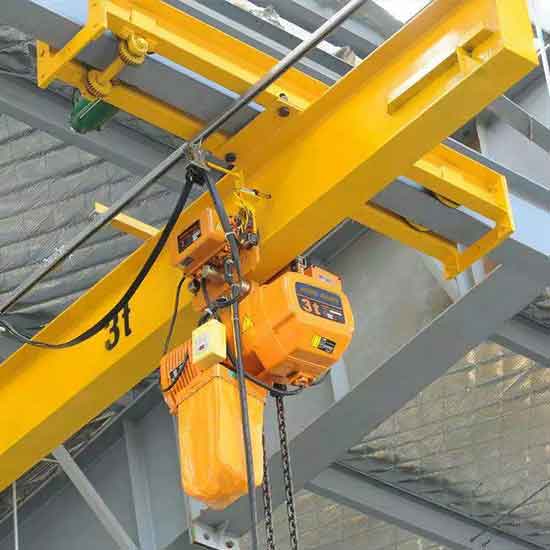
Single girder underhung bridge cranes & underslung cranes:1 ton -10 ton underhung bridge crane, light single girder overhead crane design, suspended on overhead roof, free floor space, economical underhung crane.
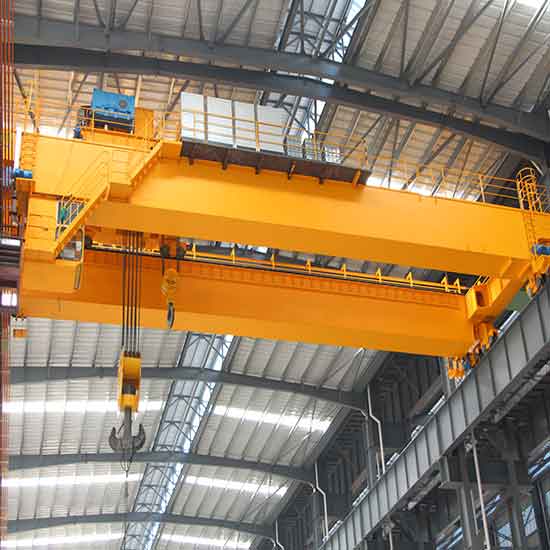
FEM/ DIN open winch bridge crane: European winch trolley, Heavy duty hook cranes:European standard double girder overhead crane with open winch trolley, your heavy duty winch crane up to 320 ton, wide specifications hook cranes for wide application.
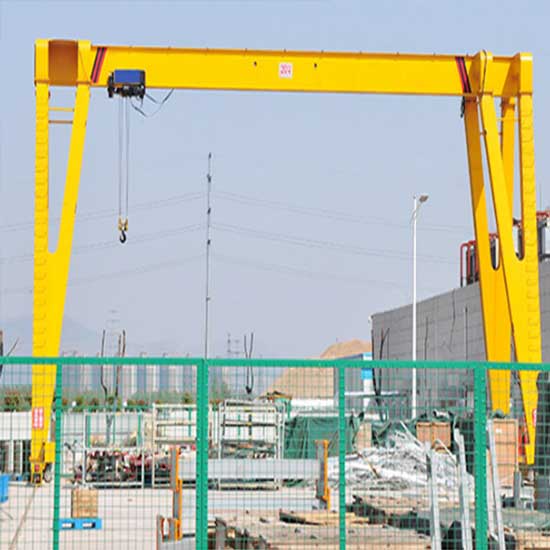
Single girder hoist gantry cranes, FEM,DIN & ISO standards: Single beam gantry cranes, European style box girder, FEM hoists for 3 ton, 5 ton, 10 ton, & 16 ton load handling. Good price European gantry cranes for sale.
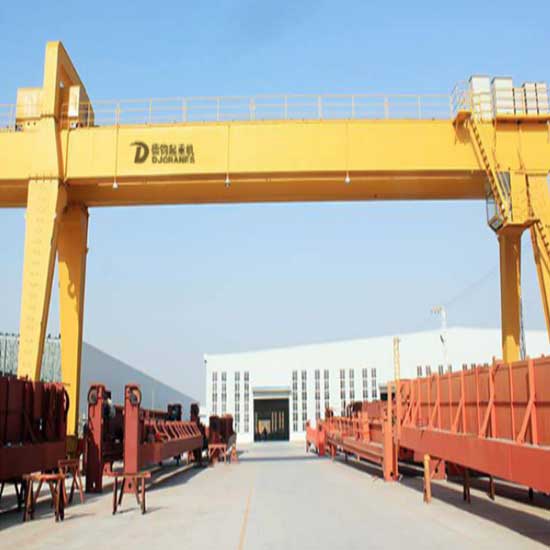
European style double girder hoist trolley gantry cranes: European type double girder gantry cranes with FEM standard wire rope hoists trolley with capacity of 5 ton up to 75 ton for sale, good gantry crane price.
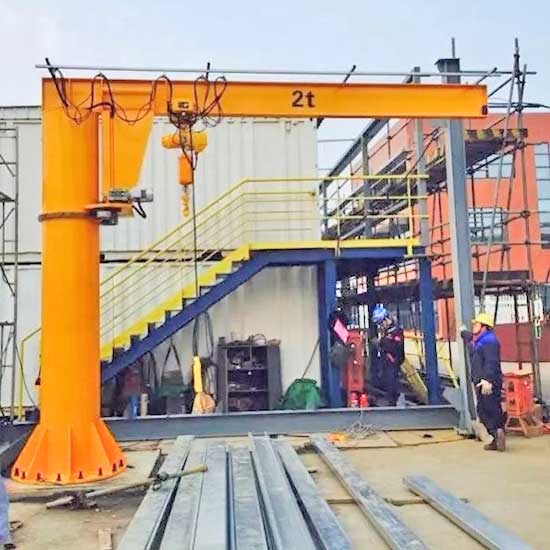
Free standing jib crane- Pillar jib crane design, floor mounted jib crane:Pillar mounted jib crane is a free standing jib crane with pillar jib mounted on floor, for short & crowded lifting, capacity up to 16 ton. Get pillar mounted jib crane design now!
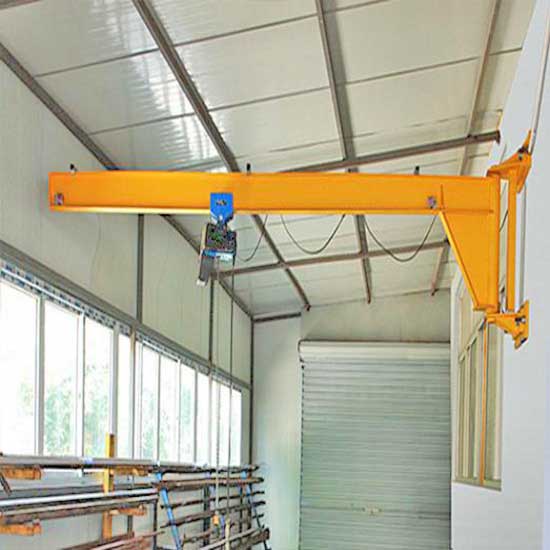
Wall mounted jib crane & wall bracket jib crane - Wall crane :Wall mounted jib crane & wall bracket jib crane with I beam & tie rod design for light duty handling with capacity up 2 ton. or less building structure changes. Wall mounted jib crane for sale.
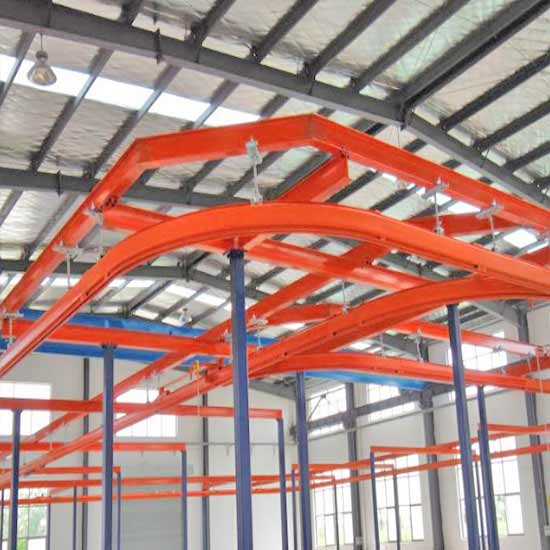
Light crane kbk system: Flexible & rigid kbk modular cranes: kbk light crane systems, flexible kbk crane & rigid kbk crane, modular crane design, cost-effective workstation crane solution, tailored light duty bridge crane.125kg to 5000kg kbk crane systems for sale.
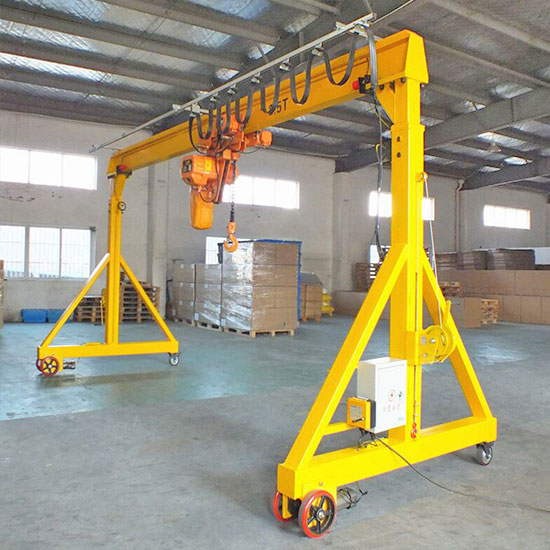
Portable gantry crane - Economical mobile gantry, Small gantry cranes:250 kg - 10 ton portable gantry cranes & mobile gantry cranes with adjustable / fixed gantry for small & light material handling. Get portable gantry crane rolling now!
What's your application conditions?
The application for which you'll need a crane is the most critical element to consider once you've identified how a crane might fit into your operation. When evaluating your crane options, keep the following aspects in mind:
Capacity and service rating are two factors to consider.
- Consider how much weight a crane can lift and how that compares to your requirements. Even marginally exceeding a crane's capacity can be exceedingly dangerous.
- Furthermore, the service rating defines how frequently the crane can be used safely, so consider whether your crane will be operated on a daily basis.
Elements that make up the structure.
- Steel or aluminum cranes are available, with steel being stronger and more robust.
- Steel-construction cranes are typically used for heavier-duty applications.
- Mechanical and electrical systems are both important.
You should also consider the crane's capabilities and whether or not they are appropriate for the job. A telescopic bridge, for example, may allow your crane to reach further and maneuver more easily around obstructions. If necessary, operator controls may enable your personnel to multitask or operate the crane from a distance.
When it comes to choosing the proper overhead crane system for your purposes, there are a number of aspects to consider. It might be difficult to choose the correct overhead crane equipment for your facility and application, but knowing your requirements ahead of time will help you avoid unnecessary complexity.
Industrial Solution
Process Cranes
Iron, steel, aluminum & basic metal processing industry cranes. Industry cranes for metal process- EAF charging & ladle crane, forging crane, finished product crane & scrap crane - for metallurgy harsh conditions, safe overhead travelling crane.
Types of industrial hoist & cranes for general manufacturing- Various types of industrial overhead crane systems for multiple sectors of manufacturing, integrated solution, maximum productivity, cost-effective price.
Mining industry cranes, Coal mine crane systems - Safe industrial overhead crane & industrial gantry crane system for ore, limestone, coke, coal, slag, loose clay handling, explosion proof and durable.
Energy generation|Industrial cranes for types of power plants - Industrial cranes & hoists systematic solutions for various power plants,i.e, traditional fuel power & waste renewable energy, wind power, hydroelectric, biomass energy, etc.
Industrial material handling cranes for mechanical engineering- Material handling cranes for mechanical engineering industry - overhead industrial crane solution for manufacturing of light & heavy machinery & equipment.
Pulp & paper| Industrial crane systems for paper making - Industrial overhead crane system for pulp & paper industry , full overhead travelling crane services, cost-effective paper making cranes for your paper mills.
Waste management|Waste recycle & sorting industry cranes - Industrial overhead cranes for waste sorting&recycling. Types of industrial cranes in incinerator for mixing, stacking, handling and stirring of the waste materials, etc.
Industrial cranes and hoists systems for timber & wood processing. Diverse overhead crane & hoists designs for material handling in sawmills or furniture plants, etc.
Industry crane systems for shipyard material handling, i.e, components assembly, boats & yachts lifting, etc. Reliable & safety industry crane system.
Industrial hoist and crane solution for plastic & rubber industry- Injection mould installation & Die exchanging- Efficient & Accurate heavy lifting systems.
Industrial material lift for construction & infrastructure- types of industry overhead travelling cranes, gantry & hoist crane system- Reliable & cost-effective.
Industry cranes for chemical & petrochemical material handling, explosion proof overhead crane & hoist system for hazardous environment.
Automotive | Industrial overhead crane & hoist for automobile - Industrial cranes for automotive industry from press & assembly lines to workstations & warehouses, i.e., open winch crane & Light kbk, jib crane & chain hoists,etc.
Basic parameters needed to get your overhead crane designs
The crane's basic parameters define the crane's main performance characteristics, and its operational capability is the foundation for proper crane selection. The lifting capacity, lifting height, working level, operating speed, and span are the basic parameters of an overhead crane.
Fundamental criteria for making a decision
The crane's basic parameters define the crane's main performance characteristics, and its operational capability is the foundation for proper crane selection. The lifting capacity, lifting height, working level, operating speed, and span are the basic parameters of an overhead crane.
1.1 Based on the weight
The rated lifting capacity of a crane refers to the greatest mass that it can lift during normal operation. The weight of the hook and the moving pulley block is not included in the crane's rated lifting capacity. Other devices, such as a grapple and an electromagnetic sucker, are used to bring the gadget inside the rated weight of the weight. However, present domestic bridge crane goods are solely based on years of production methods, which were chosen from the above part of the real series' composition based on weight. 5t, 10t, 16t, 20t, 32t, and 50t are the most prevalent series.
When the weight exceeds 10 tonnes, two lifting mechanisms, the main hoisting and sub-hoisting mechanisms, are normally configured to a weight ratio of roughly 1: 4. The main hoisting mechanism can lift a lot of weight. Heavy cargo; supplementary labor; sub-hoisting mechanism from the weight of tiny, but faster, to lift lighter items or to improve work efficiency.
Generally, the crane should be confronted with the maximum lifting weight to calculate the weight, taking into account the work environment or process requirements. Cranes are not permitted to utilize overload, thus when the lifting material is continually changing, the crane should be given a specified buffer. In some circumstances, two cranes might be used to raise overweight things on occasion. Because the weight of the lifting material remains essentially the same during the fixed operation, and the crane is completely loaded with the case, the sub-hoisting mechanism can be eliminated, simplifying the crane structure and lowering expenses. Not all foreign large tonnage bridge cranes have a sub-hoisting mechanism, but some do, depending on the need.
1.2 Lifting height
The vertical distance from the ground to the greatest lifting position of the take-up device is referred to as lifting height. The vertical distance from the ground to the lowest position of the pick-up device is called the depth of discharge if the take-off device falls below ground. The sum of the lifting height above the ground and the depth of the floor below the ground is the total lifting height at this time.
The selection's lifting height is determined by the job's needs. The lifting height of a generic bridge crane is usually no more than 20 meters. Because more than 20m of wire rope will be used in the hoisting mechanism, or the reel size will be increased, the lifting truck layout will be more complicated, and the crane size will be increased. When establishing the lifting height for cranes with loading requirements, the height of the hoist and the height of the vehicle must be taken into account to ensure that the crane can load the maximum height of the vehicle into the vehicle. The impact of tidal oscillations should be considered when loading and unloading the crane on the ship (marine facilities problem study).
1.3 The level of work
The conditions for installing a bridge crane and using it vary greatly, as does the usage of lifting capacity and the frequency with which it is used. In order to use the crane efficiently and sensibly, choose the right degree of work based on the crane's working conditions. The working grade of an overhead crane is classified into A1 to A8, which can be decided based on the crane's utilization level and load status, that is, the busy and full load degrees.
During the crane's lifetime, it will complete a specific amount of total working cycles. A crane operation's working cycle is the full procedure from the start of the lifting item's preparation to the end of the lifting item's preparation. The crane's usage is measured by the total number of work cycles. The total number of labor cycles is divided into ten utilization levels within its potential range for ease of calculation.
The crane's load status reflects how heavy the load is. The ratio of the real hoist load Qi to the rated weight Qmax, and the ratio of the number of times Ni to the total number of cycles N of the actual lifting load Qi, are both related to the load condition. The crane load spectrum coefficient KQ can be derived by multiplying the nominal load spectrum coefficient by the index of the material fatigue test curve, which in this case is m = 3.
The nominal load spectrum that comes closest can be found.
The crane's working level can be established when the utilization level and load status have been determined.
The bridge crane's working grade can also be set.
1.4 Working speed
The lifting speed, trolley running speed, and cart speed all contribute to the overhead crane's working pace. Working speed is determined by a variety of things. First and foremost, with the crane's weight, medium and small weight cranes should use high speed to increase productivity, while large weight cranes should use low speed to minimize drive power and improve operation smoothness and safety.
Working speed is also determined by the work level and application requirements: high level of work, frequently used, requiring high crane productivity; low level of work, for the operation of the adjustable operating mechanism, choose low speed; only for equipment installation and maintenance, choose low speed. In addition to low-speed, the crane should utilize two-speed (quick, slow), micro speed, or speed, depending on the situation. The use of frequency control allows for arbitrary speed adjustments between 1:10 and 2:10. Work speed is also affected by the size of the crane's service space; for a lengthy voyage, a high-speed crane should be used.
When the crane is running a short distance, high-speed is not recommended so that the crane does not start after the start brake. However, as modern industry develops, cranes that perform a lot of heavy work, such as installation and maintenance of a large number of cranes, are increasingly being used at fast speeds. There should be a rapid descent device for some special functional cranes, such as cranes for work hardening operations; the crane's large lifting height should be appropriately increased in accordance with the lifting speed, but also heavy-duty low-speed, no-load using high-speed, or Take measures to achieve a faster rate of descent to increase productivity.
1.5 Span
The span is the horizontal distance between the bridge crane's centerlines. The crane's span is mostly determined by the width of the service space, while the crane's span within the plant is determined by the width of the structure. Bridge cranes often used span every 3m for a level, observe the precise value, in order to serial parameters of the span. For each plant span, a crane with a weight of less than 50t has two span values and a minor value in the case of a safe passage on the crane beam above the plant.
If there are more than 80t cranes on the same track, cranes with a capacity of 50t or less are picked, and cranes with a span of 80t or more are selected. When there are two cranes on the same span, the table values only apply to the higher cranes, and the lower cranes' span should be an integer multiple of 015 m. Special design cranes are used when the span does not satisfy the values specified in the table.
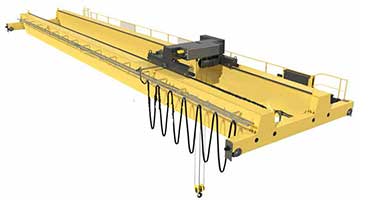
Double girder overhead crane crane specification & crane drawing
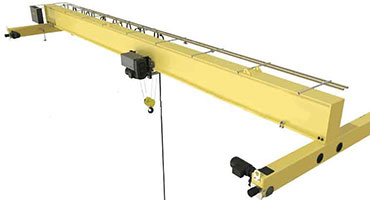
Single girder overhead crane crane specification & crane drawing
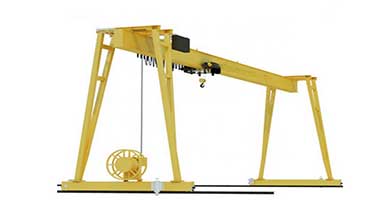
Double girder gantry crane crane specification & crane drawing

Single girder gantry crane crane specification & crane drawing
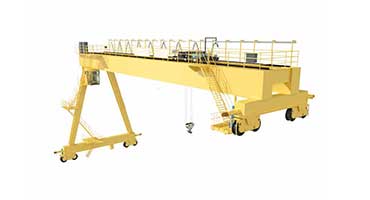
Single leg gantry crane crane specification & crane drawing

Floor jib crane crane specification & crane drawing
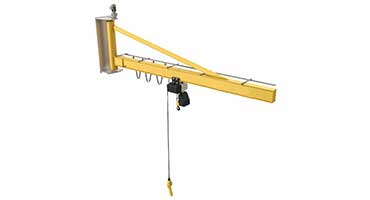
Wall jib crane crane specification & crane drawing

Suspension crane crane specification & crane drawing
Choices of structural form
The bridge crane can better satisfy the needs under various installation and operation modes by selecting the proper bridge, lifting trolley, maneuvering mechanism, and take-up device.
2.1 Bridge girder
The metal structure's main body is the bridge. The bridge crane has two types of bridges: single beam bridges and double beam bridges. Single beam bridges have one or two main girders and one end beam on both sides of the span. Double beam bridges have one main girder and one end beam on both sides of the span. Under the weight of 10 tonnes, the work level is low, the span is small, the running speed is low, the crane is not frequently used, and single beam bridges are commonly used.
As a hoisting mechanism, this single-beam crane is normally operated by an electric hoist, which makes it compact, light weight, and inexpensive. In other circumstances, a double beam bridge can be used, which has good stability, good stress conditions, and superior operating performance.
The shape of the bridge can be altered to match the requirements of a certain plant building structure. Under typical conditions, the primary beam and the end of the beam join horizontally, making it simple to produce and adjust.
When the plant building structure has been determined in order to fulfill the lifting capacity and lifting height requirements, the main beam can be used in the shape of a concave in the case of a high trolley. The main beam and the end beam might sometimes be equivalent to the high connection in order to reduce the height of the plant crane beam and limit the weight of the plant's building structure.
2.2 Lifting car/ Lifting trolley
Lifting trolleys are utilized to achieve lifting and lifting along the bridge, and their performance has a direct impact on the crane's overall performance. The type of lifting vehicle, carrying capacity, and smooth operation of a double beam bridge crane are commonly employed, but the size of the crane is huge. The hoisting mechanism of this lifting car is usually consisting of a motor, reducer, and reel. You can utilize an electric hoist as a lifting device to reduce the height of the building, reduce the weight, and simplify the structure.
The weight of the electric hoist bridge crane machine is about 30 percent less than that of the previous model, making it more suited for plant structures on the height and wheel pressure, which has limited the situation, and it has a large number of foreign users.
Electric hoists as lifting and trolley power single girder cranes, which are suspended in the bottom section of the single girder. This structure is lighter and less heavy. However, the gourd will have an impact on the height rise.
Sometimes the plant building height is low, but to enhance the height of the case as much as possible, the choice of a low construction height electric hoist single girder crane is made. To raise the lifting height of the purpose, this crane is connected to an electric hoist installed on the side of a single beam. This type of crane necessitates special precautions: the hanging electric hoist must increase the counterweight to maintain balance, but this also increases the weight; the other uses the car side hanging, but this also increases space efficiency, but the car structure is complex, so it is also necessary to take special precautions. The primary beam is held in place by a torque.
2.3 Crane control
The common use of the driver room to ensure safe operation is for large, high-level work, fast-moving cranes.
Typically, the cab is parked on one side of the bridge. If the crane span is large, and the operation is complicated, the driver room with the lifting vehicle with the form of movement can be used. You can sometimes choose to move the driving room along the main beam for free and more easy operation.
In the plant, low or high ground equipment, the driver's room cannot be installed; there are dangerous gases in the higher portion of the plant, and ground manipulation can be utilized in the case of manipulation. The maximum speed of a ground-operated crane is 45 meters per minute. Ground control with a fixed hand-held door, a hand-driven door that moves with the automobile, and a flashlight door that moves in a variety of directions, depending on the requirement.
Because of the usage of a ground control cable, the operator must closely monitor the crane's movements. It is also possible to utilize a wireless remote control mode, such as infrared light or radio remote control, to make the crane's operation more flexible and convenient. This method of operation is frequently used in other countries.
2.4 Below-hook-devices
It is critical to select the suitable take-up equipment for safe production and increased efficiency. Due to the great diversity of objects that bridge cranes load and unload, there are fragments, scattered and liquid, and so on, each with their own physical qualities and geometric shapes. Hooks, grabs, electromagnetic sucker, rings, tie, clamp, vacuum sucker, hopper, Sheng barrels, and load-bearing beams, as well as container cranes with other unique tools, are regularly used extraction devices to adapt to the loading and unloading of diverse commodities.
The most common picking device for bridge cranes is hooks. Grab is primarily used to load and unload vast quantities of scattered material, although it can also be used to grab a wooden grapple. Grab is an automatic take-up device that allows the driver to grasp and unload cargo without the use of assistants in the driver's compartment, considerably increasing loading and unloading productivity. Electromagnetic sucker is used to raise metal materials with magnetic permeability, although it is usually only used to absorb 500 degrees Celsius below the black metal.
The choice of dual-use bridge crane, take the device is grab and electromagnetic sucker, or grab and hook, or electromagnetic sucker and hook, in the event of frequent changes in the lifting material and greater productivity needs. On the hoisting car, there are two distinct hoisting mechanisms that drive the gadget individually. The two takeover devices, however, cannot operate at the same time.
On the basis of the need to hang in the hook on the electric grab or electromagnetic sucker, you can choose three bridge cranes, crane crane in the hook on the basis of the need to hang in the hook on the electric grab or electromagnetic sucker in the lifting of the material frequently changes, but the productivity requirements are not very high special occasions, you can choose three bridge cranes, crane crane in the hook on the basis of the need to hang in the hook on the electric grab or electromagnetic sucker.
Choice of running performance
Particular requirements for the crane's performance, such as environmental requirements, automatic control, and safety protection requirements, may be required in order to meet the criteria for the usage of bridge cranes under special environmental conditions or under specific situations.
3.1 Environmental requirements
When beyond the scope of the need to take extra measures in the acquisition of cranes to make particular requirements, bridge cranes are normally in the -25 to 40 °C temperature range to normal operation. In a low-temperature environment, the crane should be used to choose the insulating chamber, and the metal structure should have a low temperature sensitivity and a higher impact toughness. In the case of high temperatures and the handling of red or molten metal cranes, the main beam should be installed under the cover and even the web should be installed insulation layer, and the electrical device should be appropriate cooling measures to avoid high temperature radiation of the main beam.
Bridge cranes should be used outside only if it is raining. Rain covers should be installed for lifting cars, carts, and electrical equipment. In the event of multi-dust cranes, a sealed electrical room should be chosen, and electrical equipment should perform dust-proof.
When working in a flammable and explosive mixed gas environment, consider an explosion-proof crane. Different explosion-proof grades can be classified based on the type of explosion, the use of the environment, the properties of the explosive gas mixture, and the maximum surface temperature. Cranes with motors and electronic control devices must be flameproof, and the transmission mechanism may be subject to friction heating sparks, necessitating the employment of necessary safeguards, such as reducing the crane's working speed to ensure safety.
Due to the completion of feeding, replacement of electrodes, and lifting electrolyte in a strong current electrolytic cell, the spreader in an aluminum, magnesium, and other electrolytic smelting workshop used bridge crane, the relevant parts of the crane must be insulated to ensure that personal with the safety of the equipment. As a result, you should opt for a three-stage crane insulation system: between the hook and wire insulation; between the hoisting mechanism and the insulation between the car; and between the car and folding between the insulation. Each insulation resistance must be more than one millionth of a millionth of a millionth of a millionth of a million
Cranes employed in metallurgy, petroleum, chemical, port, and heat treatment plants can occasionally cause substantial corrosion of the crane's metal frame as a result of working in corrosive environments, endangering the crane's safety. As a result, the crane's anti-corrosion capacity should be used, and the metal material should be corrosion-resistant steel or use of an efficient anti-corrosion coating. The influence of corrosion should be considered in structural and process design, as well as the employment of a sacrificial anode protection strategy to achieve the corrosion goal.
3.2 Automatic control
With the increasing degree of production automation, the bridge crane can take full advantage of space, has been utilized as a mobile robot in space, and is one of the important equipment for material handling automation. The advancement of automatic control and electrical drive is critical to the crane's renewal and development. According to foreign specialists, the automation technology will be installed in the next 20 to 30 bridge cranes.
In order to precisely convey the items, enhance production efficiency, and minimize spreader shaking and ineffective positioning, the crane with automatic crawling function should normally choose the anti-shake feature of the spreader. Spreader anti-shake mechanisms include mechanical, hydraulic, electronic, stiff guide rod, and other designs. To obtain the finest anti-shake control, foreign companies developed fuzzy logic circuit control technology.
Certain specific circumstances, such as lifting nuclear fuel or installing precision parts, necessitate precise positioning of bridge cranes. Positioning precision requirements should be considered when selecting such cranes. The screen automatically displays the coordinates, as well as a variety of handling activities, depending on the needs, but also in the driver's room to install the computer.













